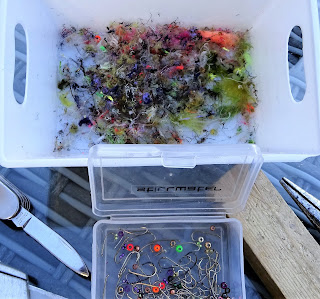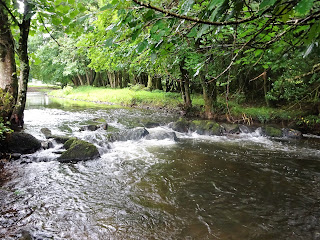Ed 8 And so it came to pass
Ed 7 gave a flavour of my tackle tinkering intended tasks. I can report that there has been some progress: all reels checked, some lines swapped over, leaders re-tied (including a blitz on braided loop connections), lanyard and equipment thereon remodelled, bits n’ pieces boxes similarly, and the fishing vest (which is part of me) also revisited and reloaded as required. The rods and landing nets are all clean and hunky dory.
And so it comes to pass that I’ve made a start on that numero uno, the big one: the investigation of the fly boxes and their contents; exhaustive detail, fine-tooth comb, under the microscope, you name it. So far, I’m three boxes in. The ‘furry’ one (snakes, mohicans, zonkers) passed with flying colours, an open and shut case, so to speak. The other lot, however, have had their contents very much reduced. As previously mentioned, each fly is scrutinised, if I like it, it goes back but sometimes into a different box, (how to sort and arrange a collection of flies is a whole other topic which may become a post in the future). Those I reject have one of three destinies, let’s call them A, B, and C.
‘A’ are patterns which I have every confidence will catch fish and would normally keep, but for the fact that I have plenty in hand, so some are given to fishing buddies who don’t tie their own. Yes, I could keep them as a stock of spares, but I like tying, a whole other hobby akin to the main one.
‘B’ ones are well tied (in my humble opinion) but don’t have the je ne sais pas that means I would use them, that confidence thing. They are largely the result of experimentation, possibly utilising unfamiliar, new materials (or combinations) arising when I’m improvising at the vice. Actually, the rock fan within would rather use the phrase ‘riffing’, in the sense of playing around with an established pattern. Some of these results don’t cut it for me, but if someone else likes them enough to give them a try then I’m happy to pass them on. Sometimes our branch of the Fly Dressers Guild attends country fairs/shows to promote our fantastic hobby, and its nice to have some freebies, especially for youngsters and fly fishing noobies.
‘C’ flies are the sad rejects. Once thought good enough to go into the working collection, possibly new creations awaiting a trial, they are now unlikely to be ever used again, unwanted, superseded and superfluous. Rather than simply dispose of them, I prefer to salvage what I can re-use, the hook and maybe the bead or bead chain (if any). There is an economical side to this, albeit slight, because hooks currently cost at least 15p (18c US) each, with beads about the same, except tungsten ones which cost more. Salvage it is.
The best way of taking these Cs apart is using a sharp safety knife, long-nosed pliers, and a small block of wood as a mini saw-horse. Good tweezers can be a help too. The thread and materials are cut away, layer after layer; it’s fiddly and time-consuming, but I’ve yet to find a better way. Once I considered burning, much quicker, but then the addled brain remembered hooks are made from tempered wire so burning would be detrimental – softening what ought to be stiff!
Just like in those old horror movies, dissection is not merely a dismantling but also a source of knowledge, we can learn from the process! After a few hours sitting in the spring sunshine while wielding the knife, here are a few observations, in no particular order:
~Most of my nymph-style patterns are overdressed; it was striking how some looked much better with up to half of the material removed! Less is more, as they say.
~Mylar strands (especially the smaller, finer sizes) are often used for wrapping bodies, or ribbing, or flash-backs/wing cases, but they easily slip out of place and are fragile too, unless secured with glue, varnish, or resin for longevity.
~Even one dunk into water (maybe the one time the tie was tried) can lead to a spot of rust on the hook, the thin end of the wedge. (Any I found with even the slightest spot of rust were carefully and safely cut up with a wire cutter, then binned). The observation here is that you should not rely on a particular fly over and over, at some point rust may cause it to snap or straighten. Perhaps used flies shouldn’t be returned to the fly box but retained on a fly patch until missing in action or the annual clear down?
~Lead wire wound over a thread base then superglued is much sturdier than lead wrapped onto a bare hook-shank and then wrapped and glued.
~Pay attention to finishing-off the fly on your vice! Many of my ‘thread heads’ were poorly whipped and badly varnished. Once the main tying operations have been accomplished it is all too tempting to rush the tying-off. I know I am not alone!
~Micro bead-chain eyes, like ordinary bead-chain, are relatively inexpensive and so not really worth trying hard to salvage. If one comes off clean without too much effort it is a bonus, otherwise bin them with the rest of the waste.
Only the tip of the iceberg so far, in terms of the total number of fly boxes, but some of them are already in quite good shape, so I won’t expect many Cs from those.





Comments
Post a Comment
Comments and/or feedback are always welcome